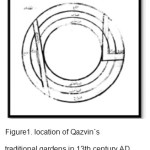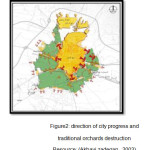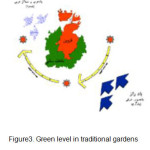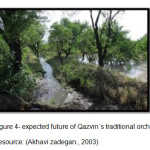Strategic Vision of Qazvin's Traditional Orchards
Seyed Rahman Eghbali1 * , Zahra Motevali Alamouti2 and Farzaneh Shahsavari2
1
School of Architecture and Urbanism,
Imam Khomeini International University (IKIU),
Qazvin,
Iran
2
Imam Khomeini International University (IKIU),
Qazvin,
Iran
Corresponding author Email: s.r.eghbali@arc.ikiu.ac.ir
DOI: http://dx.doi.org/10.12944/CWE.10.Special-Issue1.135
Qazvin is located in a semi-arid zone within the Iranian Plateau. Qazvin`s traditional orchards with a history spanning a thousand years, are a distinctive and unique heritage. Nowadays this heritage is threatened by unrestrained urban and industrial developments, administrative shortcomings and insufficient public awareness. Trees have always been considered as one of the blessings of nature, Preserve this traditional orchards should be one of the most important issues in City strategies. This survey, regarding the environmental, cultural and economic benefits of the trees, introduces a strategic vision for Qazvin’s traditional orchards and emphasizes on a plea for the relevant strategic plan.
Copy the following to cite this article:
Eghbali S. R, Alamouti Z. M, Shahsavari F. Strategic Vision of Qazvin's Traditional Orchards. Special Issue of Curr World Environ 2015;10(Special Issue May 2015). DOI:http://dx.doi.org/10.12944/CWE.10.Special-Issue1.135
Copy the following to cite this URL:
Eghbali S. R, Alamouti Z. M, Shahsavari F. Strategic Vision of Qazvin's Traditional Orchards. Special Issue of Curr World Environ 2015;10(Special Issue May 2015). Available from: http://www.cwejournal.org/?p=11698
Download article (pdf) Citation Manager Publish History
Select type of program for download
| Endnote EndNote format (Mac & Win) | |
| Reference Manager Ris format (Win only) | |
| Procite Ris format (Win only) | |
| Medlars Format | |
| RefWorks Format RefWorks format (Mac & Win) | |
| BibTex Format BibTex format (Mac & Win) |
Article Publishing History
| Received: | 2015-02-20 |
|---|---|
| Accepted: | 2015-03-30 |
Introduction
Population growth and development of cities encourages developers to use urban lands more than ever and so causing more stress to open spaces and specially farm lands around towns. So achieving an efficient method to preserve these lands looks necessary. Experiences of previous decades show that urban development plans and their terms and conditions to preserve gardens and farm lands were not efficient enough and these lands are continuously disturbed by the non-stop rise of the suburban land prices. This has led to an uncontrolled removal of trees, especially in Qazvin s traditional orchards.
Qazvin has always been low in terms of water resources, but due to its location, it has been a populated area; therefore gardens were considered a vital necessity for the population (Parhizgari et al., 2012). Traditional gardens were so important in Qazvin`s culture and life that Dehkhoda - a prominent Iranian linguist, and author of the most extensive dictionary of Farsi - selected "Dakho" as his literary pseudonym which means the guardian of water’ (www.yjc.ir., 2014). Qazvin s suburban traditional gardens have turned it to a large garden-city, meaning that the city was surrounded by a chain of gardens that shaped a green belt around the city, protecting it from severe climatic conditions, as well as being a great source of income for its inhabitants. During last three decades, the city is expanded toward its green belt, a large number of these treasurable trees were removed and the integrity of the orchards is threatened.
History of Qazvin`s Traditional Orchards
Qazvin`s traditional orchards – some of them 1400 years old – are examples of sustainable attitude. These orchards emphasize the peaceful approach and profound knowledge of the inhabitants of Qazvin, resulting in a slow-paced but thoroughly sustainable development (Research report., 2008). Some early documents about these traditional gardens are travelogues of scholar travelers who visited Qazvin and mentioned its splendid disclosed gardens, without any walls or enclosures.
In addition to Nasir Khosrow Qobadiani (Qobadiani., 1997)who has mentioned the disclosed orchards of Qazvin in his travelogue, Zakariya Qazvini in his book namely Athar-al-Belaud (Golriz., 1959),has also described Qazvin at the beginning of 13th century AD as such: Qazvin is a very big and populated city located in a vast and flat plain with a brilliant plan. In fact, it was the variable vegetation and the fruit trees of the orchards, in such a relatively dry land with no permanent river, which had attracted the attention of the travelers.
 |
|
Current Status of the Orchards
Qazvin`s traditional orchards are situated on the eastern, southern and western surroundings of the city; in the recent past they used to cover an area of nearly 3000 hectares. From the 1960 s on wards about 800 to 1000 hectares of these orchards were abandoned or transformed for residential and other uses and thus partly destructed. Presently there are about 2600 hectares of these orchards left, from which some areas are under severe conditions, some other under semi sensitive conditions and a large area is still green and fruitful. Various factors have caused the destruction of the orchards or are considered as threats as followings:
- expansion of new urban developments
- Industrial development
- Construction of a ring road in the area and passing gas pipeline
- Constructional waste disposal in the area
- Building access routes to Rasht, Hamadan and Tehran
- Construction of railway station
- Irrigation problems (lack of timely irrigation, irrigation method, etc.)
- Frequent fires (in 2002, about 300 hectares of orchards burned) (Akhavi zadegan., 2003)
- Small private motor service shops
- Littering
- Tree removals
 |
|
Importance of a Tree and its Value
Biodiversity is in close contact with human needs, resulting in a vital importance and can be considered as a matter sustainability. Environment, at both local and global and levels, is subject to serious threats. These threats include issues from global warming to loss of biodiversity and air, water and soil pollutions. A tree has a key role in preserving an environmental platform to produce agricultural products by controlling water and wind together with recycling vital nutrients to soil. In fact, trees provide a wide range of environmental, social and economic benefits that improve our living quality. Trees purify the air by absorbing harmful gases and pollutants, such as Carbon Dioxide, which is the main factor in climate change, and improve air quality by reproducing oxygen.
- A mature tree absorbs 12 Kg Co2 (36$) yearly.
- A mature tree absorbs particles and polluted gases of air (185-370$) yearly.
- A mature tree decreases air temperature 5-10 F yearly and is known as a "temperature island" in urban areas (almost equal 62000$)
- Each 1000 trees planted in northwest of Qazvin resulted in saving 1 million$ in managing surface sewage, decreasing pollution and costs of energy in the area. This points out the importance and value of the orchards in the northern margin of the city that once existed and are removed (land of volunteers.com., 2014)
- The amount of oxygen produced by A 50 year old tree equals to 31250 $, as well as a value of 37500 $ for air purification (keptics. stack exchange.com., 2014)
Characteristics and Function of Qazvin`s Traditional Orchards
The relevant characteristics and function could be summarized as the followings:
- Planting in south east of the city turns hot wind to cool and humid, as well as reducing haze.
- Planting in northwest of the city reduces cold wind and protects the city from relevant impacts.
- Irrigation methods in orchards are consistent with the water resource limitations of Qazvin.
- Planted species in orchards are completely compatible with the climate of the city (i.e. almond tree has strong roots which are able to penetrate 3m vertically in soil, making it able to meet water needs from deep down the soil in case of drought and dehydration).
- Providing flood control (irrigation canals divide floodwater, making use of it to irrigate gardens and protect the city from flood.
 |
|
Table1: Overall SWOT table of Qazvin`s Traditional Orchards
|
Aspects |
Strength |
Weakness |
Opportunity |
Threat |
|
Environmental, Social, Economic |
Air Purification Compatibility with climate Diversity of garden products Fertile soil High percentage of live and green gardens Flood control Air conditioning Orchards as identity and cultural heritage High economic values of garden products (walnuts, pistachio, grapes, etc.) Access and proximity to city as a product market Already established Qazvin Orchards Organization
|
· Lack of public awareness · Lack of detailed preservation regulations · Lack of incentives for owners · High costs of Gardening and irrigation, low income of gardeners (lack of enough profitability)
|
· Tourism capacities · Environmental advantages · Cultural characteristics · Economic values · UNEP support · Local authority’s approach |
· Tree removals · Littering · Inappropriate urban developments · Indifference of owners · Suburban lands increasing prices
|
Vision of Qazvin`s Traditional Orchards
In 2030 Qazvin`s traditional orchards are regained their freshness and greenness and contribute to the health and welfare of the society, as well as livelihood and urban prosperity of Qazvin. Subsequent to the recognition of these orchards by international organizations; owners, citizens and local authorities pay more attention to healthier preservation of these orchards. The undesired out-of-control developments are terminated and the relevant areas are restored to their original state of greenness. In addition to environmental advantages of the orchards, there are also several economic benefits emerging from them, reassuring the sustainability of the social and economic growth. The orchards are not only promoted through conventional marketing, but are also turned into a cultural movement, attracting people not only to benefit from its gifts but to actively contribute to it.
People are now aware of historical and cultural value of these orchards as well as their undeniable impact on Qazvin`s climate. This awareness urges local authorities to rub shoulders with people to preserve, protect and promote the orchards. UNESCO consideration of Qazvin s Orchards as a world heritage site, has turned them into a tourist hot-spot, providing a great opportunity for employment of the locals, cultural exchanges and ecological awareness.
 |
|
Results
It could be concluded that Qazvin s traditional orchards are not only cultural and natural heritages but also environmental and economic properties for Qazvin, where every single tree could be regarded as a productive entity of a tangible commercial value, a symbol of historical and cultural identity and an example of efficient environmental sustainability. The overall SWOT table demonstrations that the orchards possess a strong potential to realize the foreseen strategic vision, meaning that there is a plea for a carefully studied strategic plan.
References
- Akhavi zadegan, A. research report in reviving and organizing Qazvin`s traditional gardens, (2003).
- Golriz, M.A. Minoudar or Bab al janat Qazvin, Tehran, University of Tehran (1959).
- http://landofvolunteers.com/per/news/plants/articles/benefits-of-trees.html (2014).
- http://skeptics.stackexchange.com/questions/16007/is-the-value-of-a-tree-193-250 (2014).
- http://www.yjc.ir/fa/news (2014).
- Parhizgari, M. Qazvin`s article collection, 2nd vol., Ronas publication (2012).
- Qobadiani, A.N. K. Safarnama, corrected by Seyyed Mohammad Dabir Siaghi, second addition, Tehran: zavar (1997).
- Research report of Avarth urbanism and architectural consultant engineers, (2008).







